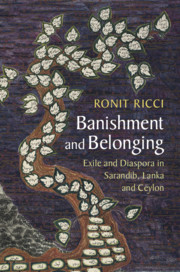Book contents
- Banishment and Belonging
- Asian Connections
- Banishment and Belonging
- Copyright page
- Contents
- Figures
- Maps
- A Note on Orthography and Manuscripts
- Acknowledgments
- Abbreviations
- Maps
- 1 Introduction
- 2 Diasporic Crossings: Malay Writing in Nineteenth-Century Ceylon
- 3 Remembering Java
- 4 “Ceyloned”: The View from the Other Shore
- 5 Exilic Journeys in Time, Place and Writing
- 6 Nabi Adam: The Paradigmatic Exile
- 7 Banishment and Interreligious Encounters: A Malay Ramayana
- 8 Ceylon Malays: Military and Literary Paths
- 9 Malay Writing in Ceylon: Roots and Routes
- Glossary
- Bibliography
- Index
3 - Remembering Java
Published online by Cambridge University Press: 11 November 2019
- Banishment and Belonging
- Asian Connections
- Banishment and Belonging
- Copyright page
- Contents
- Figures
- Maps
- A Note on Orthography and Manuscripts
- Acknowledgments
- Abbreviations
- Maps
- 1 Introduction
- 2 Diasporic Crossings: Malay Writing in Nineteenth-Century Ceylon
- 3 Remembering Java
- 4 “Ceyloned”: The View from the Other Shore
- 5 Exilic Journeys in Time, Place and Writing
- 6 Nabi Adam: The Paradigmatic Exile
- 7 Banishment and Interreligious Encounters: A Malay Ramayana
- 8 Ceylon Malays: Military and Literary Paths
- 9 Malay Writing in Ceylon: Roots and Routes
- Glossary
- Bibliography
- Index
Summary
This chapter draws on materials from colonial Ceylon to explore both personal and collective expressions of memory as it relates to the archipelago and especially to Java, and considers the shifts occurring in these memories’ construction and representation with the passage of time. In addressing textualized memories and links to the archipelago, it expands the discussion of these themes presented in Chapter 2, but differs in the writing genres it explores, their tone and their atmosphere. Whereas Chapter 2 focused on intellectual and religious currents of connectivity and memory, the present chapter engages with individual voices and traditions of storytelling and cultural heroes as transmitted to the diaspora. More specifically, the analysis draws on a clandestine exchange of letters written by royal exiles in the early eighteenth century and on evidence of the transmission of the Javanese wali sanga tradition (on the "nine saints" said to have converted Java to Islam) to the Ceylon disapora.
- Type
- Chapter
- Information
- Banishment and BelongingExile and Diaspora in Sarandib, Lanka and Ceylon, pp. 49 - 75Publisher: Cambridge University PressPrint publication year: 2019

